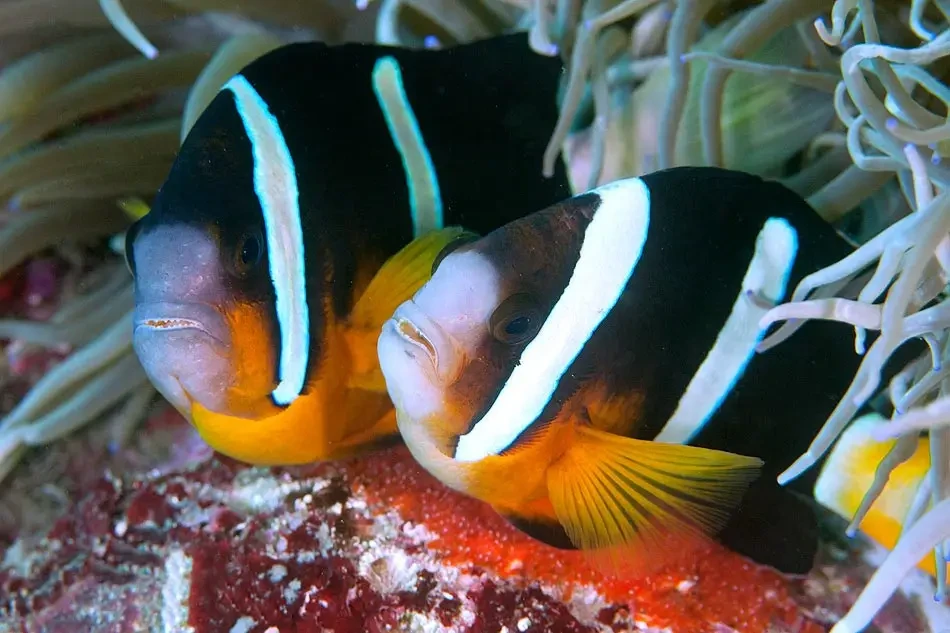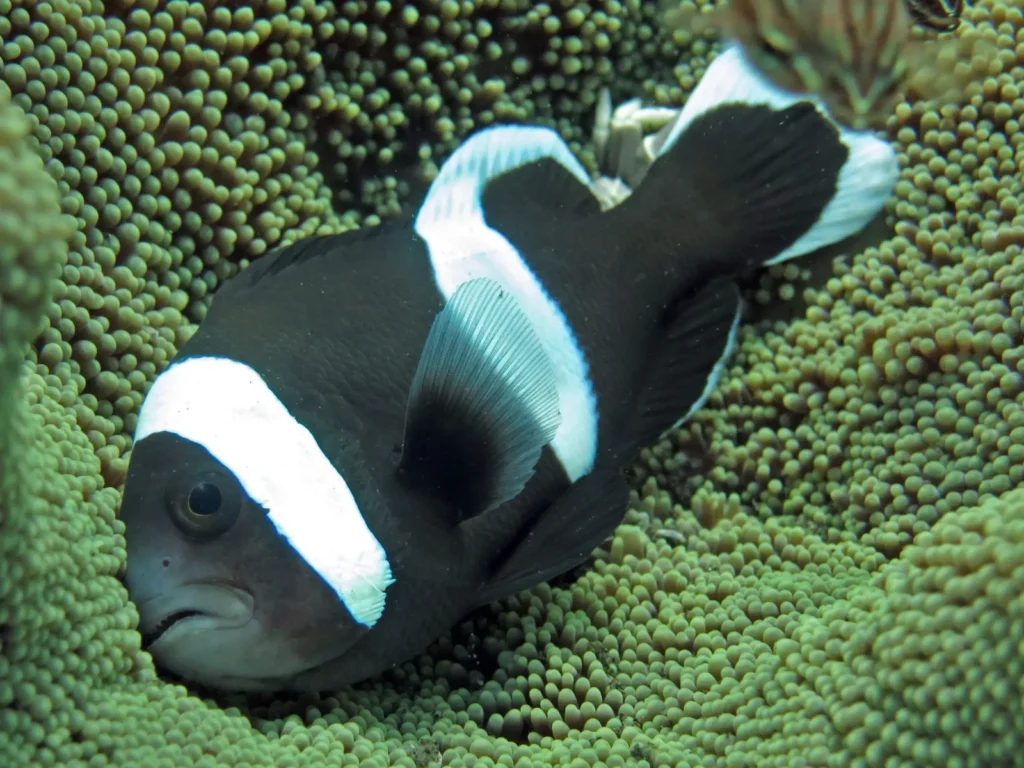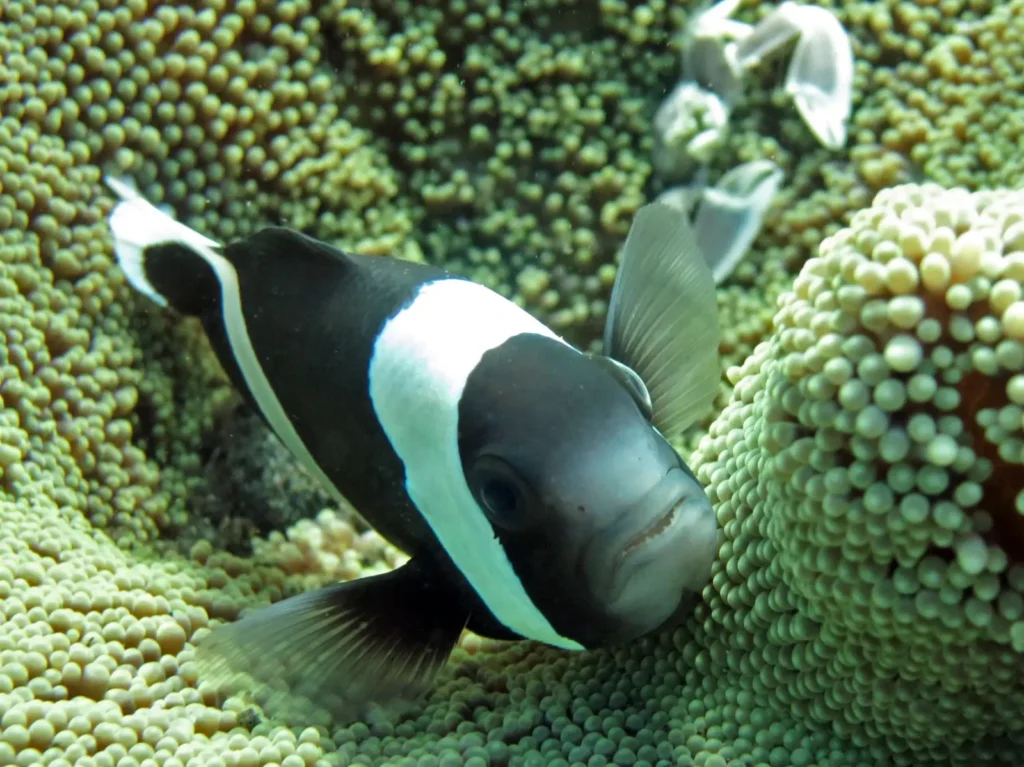Among the variety of clownfish Amphiprion clarkii It is one of the most adaptable and hardy species. It is found in different parts of the ocean, adapts easily to different conditions, and is able to co-exist with many species of sea anemones.
✔ The most hardy among clownfish
✔ It lives in symbiosis with 10 species of anemones
✔ It is found in many marine regions
✔ It is popular among aquarists because of its unpretentiousness
Consider all aspects of the life of this interesting fish.

Scientific classification
✔ The Kingdom: Animals (Animalia)
✔ Type: Chordal (Chordata)
✔ Class: Lucheperi pisces (Actinopterygii)
✔ Row: Perch-like (Perciformes)
✔ Family: Pomacentrovye (Pomacentridae)
✔ Gender: Amphiprion
✔ View: Amphiprion clarkii (Bennett, 1830)
📌 Interesting!
This species is one of the most common among all clownfish.
Appearance
🔹 Body shape:
✔ Oval, flattened on the sides
✔ Elongated and strong enough
🔹 Color scheme:
✔ Black or dark brown body
✔ Two or three bright white stripes (on the head, middle of the body and near the tail)
✔ Yellow or orange fins (can be bright yellow or pale)
🔹 Sizes:
✔ Average length: 10-12 cm
✔ Maximum length: up to 15 cm
📌 Interesting!
The color of this fish can vary depending on the environment and region.
Range and habitat
🌍 Where does Clark's Clown live?
✅ Western and Central Pacific
, Indian Ocean
, Red Sea
🔹 Living environment:
✔ Coral reefs on the depths of 1-55 meters
✔ Loves sandy lagoons and reef platforms
📌 Interesting!
This fish is able to live even in muddy or muddy waters, unlike other clownfish species.
Symbiosis with sea anemones
🔹 How does symbiosis work?
✔ Clark's Clown can co-exist with more than 10 species of anemone, separately:
• Heteractis magnifica
• Stichodactyla haddoni
• Entacmaea quadricolor
✔ The clown produces special mucosal protectionwhich prevents anemone burns.
✔ The anemone provides protection to the fish, while the clown cleans it of parasites and brings food.
📌 Interesting!
This species is less choosy in its selection of anemones than others. Amphiprion percula or Amphiprion ocellaris.
Lifestyle and behavior
🔹 Social structure:
✔ Live in small groups (female, male, several young fish)
✔ Dominates the largest female
🔹 Defensive behavior:
✔ Aggressively guards its anemone
✔ Often attacks other fish that try to get close
🔹 Life span:
✔ In the wild: 6-8 years old
✔ In captivity: up to 14 years old
📌 Interesting!
If the dominant female dies, the largest male changes sex and takes its place.

Nutrition and environmental role
🥗 What does Clark's Clown eat?
✅ Small zooplankton
✅ Crustaceans
, Seaweed
🔹 Environmental role:
✔ Cleanses anemones from parasites
✔ Helps seaweed spread
📌 Interesting!
Amphiprions sometimes "invite" other fish to clean the anemone of parasites.
Reproduction and development
🔹 Method of reproduction:
✔ Female lays eggs 200-500 eggs
✔ The male takes care of the clutch
🔹 Development:
✔ Larvae hatch via 6-8 days
Young people spend several weeks in the open ocean before finding an anemone
📌 Interesting!
These fish are monogamous - if one partner dies, the other either changes gender or looks for a new one.
Clark's Clown and the Man
🔹 Popularity in aquariums:
One of the most popular clowns among aquarists
✅ Less demanding about the conditions of detention
🔹 Industrial value:
✅ Actively bred in captivity
📌 Interesting!
Because of its hardiness and variety of colors, it is often recommended for beginners.

Species conservation and environmental threats
🔹 Population status:
✅ The species is not under threat
🔹 Main threats:
Ruinuvannya coral reef destruction
Zabrudnennya ocean pollution
Pitchfork catch for aquariums
🔹 Security measures:
✔ Artificial breeding reduces pressure on wild populations
📌 Interesting!
Some marine reserves have banned clownfish fishing to protect reef ecosystems.
Conclusion
🐠 Amphiprion clarkii is one of the most versatile and hardy clownfish. Its bright coloration, unique behavior, and ability to live with many anemone species make it special among other members of the Amphiprion genus.
💡 Would you like to have such an inhabitant in your aquarium? 🌊✨